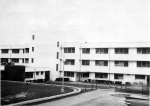Difference between revisions of "Portal:Featured Article Of The Week"
M-Explorer (talk | contribs) |
M-Explorer (talk | contribs) |
||
| Line 1: | Line 1: | ||
{{FAformat | {{FAformat | ||
| − | |Title= | + | |Title= Florida State Hospital |
| − | |Image= | + | |Image= N028810.jpg |
|Width= 150px | |Width= 150px | ||
| − | |Body= | + | |Body= The Florida State Hospital, established in 1876, is located at Chattahoochee in the panhandle of Northwest Florida. It is on the site of an old United States Arsenal, which was built in 1834, just below the junction of the Flint and the Chattahoochee River, to command the ships on the Apalachicola River. |
| − | + | Florida State Hospital was originally a Federal Arsenal, built by the U.S. Army to be used as an arms depot during the second Seminole Indian War. It was used by the Freedman's Bureau from 1865 to 1868, and then served as the state's first penitentiary. Two of the original buildings still remain; the Officer's Quarters, which now serves as the Florida State Hospital Administration Building, and a Powder Magazine, which is currently being restored for eventual use as a museum and conference center. | |
| − | + | The facility remained Florida's only state mental institution until 1947 and continues today to be the largest of a statewide system of treatment centers for individuals with mental and physical disabilities. It is listed on the National Historic Registry. [[Florida State Hospital|Click here for more...]] | |
}} | }} | ||
Revision as of 05:12, 18 December 2022
Featured Article Of The Week
Florida State Hospital
The Florida State Hospital, established in 1876, is located at Chattahoochee in the panhandle of Northwest Florida. It is on the site of an old United States Arsenal, which was built in 1834, just below the junction of the Flint and the Chattahoochee River, to command the ships on the Apalachicola River.
Florida State Hospital was originally a Federal Arsenal, built by the U.S. Army to be used as an arms depot during the second Seminole Indian War. It was used by the Freedman's Bureau from 1865 to 1868, and then served as the state's first penitentiary. Two of the original buildings still remain; the Officer's Quarters, which now serves as the Florida State Hospital Administration Building, and a Powder Magazine, which is currently being restored for eventual use as a museum and conference center.
The facility remained Florida's only state mental institution until 1947 and continues today to be the largest of a statewide system of treatment centers for individuals with mental and physical disabilities. It is listed on the National Historic Registry. Click here for more...
